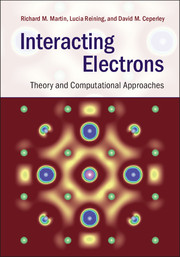Book contents
- Frontmatter
- Dedication
- Contents
- Preface
- Acknowledgments
- Notation
- Part I Interacting electrons: beyond the independent-particle picture
- Part II Foundations of theory for many-body systems
- Part III Many-body Green's function methods
- Part IV Stochastic methods
- 22 Introduction to stochastic methods
- 23 Variational Monte Carlo
- 24 Projector quantum Monte Carlo
- 25 Path-integral Monte Carlo
- 26 Concluding remarks
- Part V Appendices
- References
- Index
26 - Concluding remarks
from Part IV - Stochastic methods
Published online by Cambridge University Press: 05 June 2016
- Frontmatter
- Dedication
- Contents
- Preface
- Acknowledgments
- Notation
- Part I Interacting electrons: beyond the independent-particle picture
- Part II Foundations of theory for many-body systems
- Part III Many-body Green's function methods
- Part IV Stochastic methods
- 22 Introduction to stochastic methods
- 23 Variational Monte Carlo
- 24 Projector quantum Monte Carlo
- 25 Path-integral Monte Carlo
- 26 Concluding remarks
- Part V Appendices
- References
- Index
Summary
These two pages conclude a book of many chapters, that span an arc from fundamental theory to applications, from concepts to computation. This reflects an approach that the book is meant to promote: not the competition between research areas or methods, but the awareness that often exchange and combination leads to the most important advances.
As stated on the first pages of this book, the many-body interacting-electron problem ranks among the most fascinating and fruitful areas of research in science. It combines the intellectual challenges of quantum many-body physics with the opportunities to impact areas of science and technology, from engineering to biology, from archeology to astrophysics. There has been great progress that opens the door for the future, when all these disciplines can be greatly enhanced by quantitative calculations based on the fundamental laws of quantum mechanics.
To describe, understand, and predict the phenomena that are observed in the many-body world requires new concepts and ideas. At the same time, much of the progress in the past has been driven by the advances in computers. Very little described in this book on real materials would have been accomplished on computers from the 1970s, when many of the methods were invented. We expect this trend toward more available processing speed through parallel processing and memory to continue. Of course, advances in algorithms and software are also responsible for progress almost equally with advances in hardware. The field relies on a triangle formed by concepts, techniques, and tools: this triangle should be expanded in all directions in order to make progress.
The methods that translate concepts into feasible approaches and make best use of available hardware are at the heart of this book. We have described different ways to approach the problem. It is important to recognize that the various methods have different capabilities, so that a more complete picture of a given phenomenon or material can be obtained by using a variety of methods. The methods are complementary but not disjunct: there are many touching points that invite us to strive for possible combinations. Such an attitude has a long tradition in the field: Kohn–Sham DFT is used to construct trial wavefunctions for QMC, and QMC results of the homogeneous electron gas are used as input in DFT.
Information
- Type
- Chapter
- Information
- Interacting ElectronsTheory and Computational Approaches, pp. 674 - 676Publisher: Cambridge University PressPrint publication year: 2016
